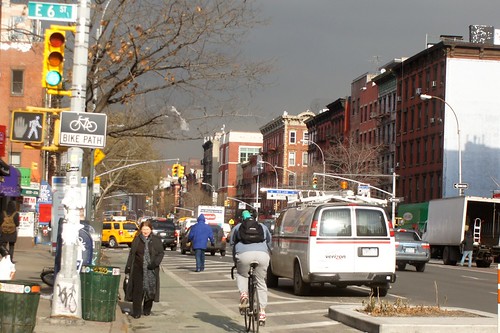The city announced on Tuesday that a record 47.8 million tourists visited New York City in 2010 and in a lot of ways that is good news. There are a plenty of things that bring visitors to New York: a fascinating history, excellent museums, and beautiful public places like Central Park and Prospect Park.
As the city noted, tourists have helped bolster the declining local economy. During his announcement at the conservatory of the Brooklyn Botanical Garden, Mayor Michael Bloomberg said that tourists contributed $31 billion last year. They have also played another positive role that has gone largely unnoticed. Tourists, in some ways, have become the newest public space activists. New York City has always been a tough town when it comes to expanding on green infrastructure, like car-free pedestrian malls and bicycle lanes. But this car-centric city is now changing. Tourists have always loved strolling in New York’s gorgeous parks and gardens and now they are also enjoying other amenities like bike lanes, open walkways in Times Square and the greenways that edge the city’s rivers. Visitors love the new green infrastructure and use it heavily – thus creating the demand for more.
The tourists are benefiting from the results of campaigns that began here; many of those efforts were a tough sell that sometimes resulted in wrongful arrests and lawsuits. Years ago local activists reclaimed abandoned lots and made them community gardens, and fought curfews in public parks. Others strove to create safer streets and safe bridge access for pedestrians and cyclists.
While activists and community members started this kind of positive change, the tourists have jumped in and are now pushing for more of the green infrastructure that visitors to New York City find so appealing. As soon as they hop off the plane, they begin to flock to our green spaces, jump in pedicabs, have picnics in the parks, and rent bikes to go on expeditions to see community gardens.
It is not uncommon to see police having to hold back large groups of tourists who are clamoring to rush across Broadway and get into the pedestrian mall in Times Square where only a few years earlier more than 1,000 bicyclists on the monthly Critical Mass ride raised their bikes in the air and demanded an auto-free zone and safer streets.
 Suzanne Rozdeba Activists in the East Village were among the first in the city to organize group bike rides calling for such changes as the installation of bike lanes.
Suzanne Rozdeba Activists in the East Village were among the first in the city to organize group bike rides calling for such changes as the installation of bike lanes.Why do so many of these visitors seem to love car-free zones and bike lanes so much? In some cases it might be because that sort of infrastructure has been common for decades in other countries. Visitors from Europe see the bike lanes and car-free plazas as familiar. People from other parts of the United States end up enjoying their experience with green infrastructure and perhaps return home to advocate for similar projects.
Many of the green infrastructure ideas that the City of New York has adopted first gained a foothold in the East Village. It was here, during the 1980’s and the 1990’s that activists and citizens were among the first to organize group ride bikes, form community gardens and work to get people to see public space in new ways. At the time some of those campaigns were considered controversial – certain city employees used to say that gardens didn’t belong in New York City – but they eventually blossomed into wide acceptance.
One of the newest public infrastructure campaigns, involving separated bike lanes like the ones on First Avenue and Second Avenue, has come in for some criticism recently. But maybe New Yorkers should take a tip from the tourists who have been enjoying the city’s bike lanes and pedestrian plazas. They might not yet be firmly established in the urban landscape, but if history is any indication it is a good bet that more and more New Yorkers will, with time, appreciate and enjoy their existence.
Bill Di Paola is the executive director of the Time’s Up! Environmental Organization, which promotes non-polluting transportation.




